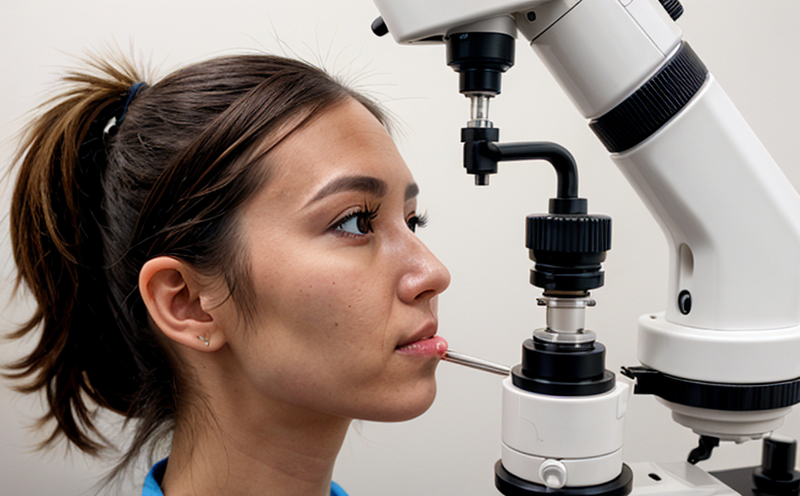ANSI Z80.7 Intraocular Lens Optical Quality Testing
The ANSI Z80.7 standard for intraocular lenses (IOLs) is a critical framework that ensures the optical quality of these medical devices meets stringent performance criteria before they are approved for use in ophthalmic surgery.
Optical quality testing is essential because even minor deviations from ideal specifications can lead to significant patient discomfort, visual distortions, and reduced quality of life. This process involves a series of tests designed to evaluate the optical properties of IOLs such as spherical aberration, coma, astigmatism, and overall wavefront error.
Our laboratory adheres strictly to ANSI Z80.7 standards, employing advanced instrumentation tailored for this purpose. Our testing facilities are equipped with cutting-edge equipment capable of performing precise measurements under controlled conditions. This ensures accurate assessment of the optical performance across various light wavelengths, ensuring that each IOL meets regulatory and clinical requirements.
The testing process typically begins with a detailed examination of the IOL’s physical characteristics, including surface finish, thickness, and dimensions, which are critical factors influencing its optical behavior. Once these initial parameters are verified, the IOL is placed in our custom-designed testing fixtures to simulate real-world ocular conditions accurately.
For spherical aberration testing, we utilize high-resolution interferometers capable of detecting minute distortions in light paths. Coma tests involve rotating the lens and measuring how the focal point varies with angle, which helps assess the lens's ability to form a sharp image across its entire field of view. Astigmatism is evaluated using specialized setups that can rotate the IOL while monitoring its optical performance.
Wavefront error testing measures the overall quality of light passing through the lens, providing insights into higher-order aberrations that might affect visual acuity. These tests are crucial for ensuring compliance with ANSI Z80.7 standards and delivering high-quality medical devices to patients.
In addition to optical performance, our laboratory also performs mechanical stress testing to ensure the IOLs can withstand the rigors of insertion into the eye without compromising their integrity or altering their shape. This comprehensive approach guarantees that every IOL undergoes rigorous evaluation before being approved for use in clinical settings.
- Interferometers: Measure spherical aberration
- Rotational setups: Evaluate coma and astigmatism
- Wavefront analyzers: Assess overall optical quality
- Mechanical testers: Ensure durability under stress
The results of these tests are meticulously recorded, analyzed, and compared against ANSI Z80.7 standards to ensure compliance. Our experienced team interprets the data, providing detailed reports that highlight any deviations from acceptable limits and suggest necessary adjustments for subsequent prototypes.
By adhering strictly to ANSI Z80.7 guidelines, we contribute significantly to maintaining high standards of patient care in ophthalmic surgery by ensuring only the highest quality IOLs are approved for use.
Benefits
Adhering to ANSI Z80.7 standards offers numerous advantages, both for manufacturers and patients alike:
- Enhanced Patient Safety: Ensures that IOLs meet the highest safety and efficacy standards before being implanted.
- Improved Clinical Outcomes: By reducing optical distortions, IOLs enhance visual acuity and overall patient satisfaction.
- Increased Regulatory Compliance: Helps manufacturers navigate complex regulatory requirements more efficiently.
- Enhanced Reputation: Establishes your brand as a leader in quality and innovation within the medical device industry.
Our commitment to ANSI Z80.7 standards reflects our dedication to excellence, ensuring that every IOL we test meets or exceeds regulatory requirements and clinical expectations.
Quality and Reliability Assurance
- Comprehensive Testing: Our laboratory performs a wide range of tests to ensure every IOL meets ANSI Z80.7 standards.
- State-of-the-Art Equipment: Utilizes advanced interferometers, wavefront analyzers, and mechanical stress testers.
- Stringent Reporting: Provides detailed reports highlighting any deviations from acceptable limits and suggesting necessary adjustments.
We maintain a rigorous quality control process that ensures each IOL tested is in compliance with ANSI Z80.7 standards. This commitment to excellence guarantees consistent, reliable results that meet the highest regulatory requirements.
Environmental and Sustainability Contributions
- Eco-Friendly Practices: We adopt sustainable practices in our laboratory operations to minimize environmental impact.
- Energy Efficiency: Utilize energy-efficient equipment that reduces operational costs while minimizing carbon footprint.
- Recycling Initiatives: Implement recycling programs for materials used during testing, reducing waste generation.
By focusing on sustainability, we not only enhance our own reputation but also contribute positively to the environment. Our efforts align with broader industry goals towards greener practices and more responsible resource management.





